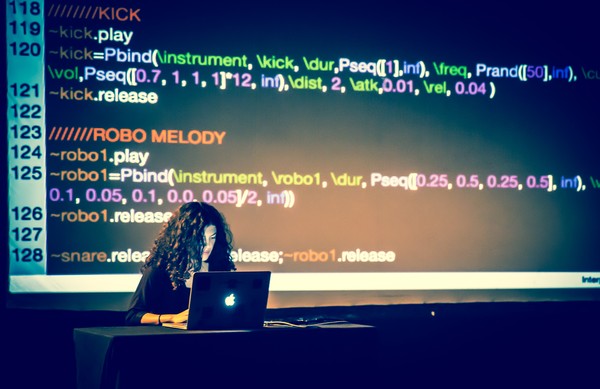
Live Coding: A New Approach to Musical Composition
Independent composer/live coder.
<http://dx.doi.org/10.12801/1947-5403.2018.10.01.14>
My work focuses on the musicality of code and the algorithmic behavior of music, research and exploration in which live coding takes a central role. In recent years, I have travelled the world, performing and teaching live coding as a performative practice for music that connects diverse social, political and artistic fields.
Live coding is a technique for writing and performing music in real time through engagement with computer algorithms. As a composer of Western classical music, my work has always leaned towards algorithmic patterning, and live coding has become the ideal tool to express my musical thought, as well as to generate a space for questioning given paradigms about contemporary music.

Figure 1. Alexandra Cardenas performing at Geiger Festival in Gothenburg, Sweden, 2014. Credit: Ruud Gielens.
For me, music must be free from aesthetic and commercial boundaries. As the Italian composer Ferruccio Bussoni said: “Music was born free; and to win freedom is its destiny” (Busoni 1911: 5). The laptop liberates me as it extends my cognitive possibilities with its capacity for the rapid calculation of stochastic processes and allows me to travel with an electroacoustic studio in my backpack. Advances in computation mean advances in the capacity of translation of my musical thought and its mutations. The computer and I nourish each other’s processes, embodying Donna Haraway’s (1991) concept of the cyborg and opening up unpredictable paths.
I am constantly looking for ways to bridge social, artistic, and technological gaps, and the use of free and libre technologies and philosophies (Stallman 2017) has proven to be an honest response to this need. Live coding works with these philosophies, nourishing a global community that thrives on inclusion, transparency, and sharing.
As composer and performer, the flexibility of computer-based music allows me to do both at the same time, improvising for the concert hall as well as the dance floor: from the Royal Conservatory of Ghent in Belgium to an algorave in Platohedro, a communal house in a working-class neighborhood of Medellin in Colombia.
Algorave (a portmanteau of Algorithmic Rave) is a scene that promotes the creation of (often live coded) music for the dance floor, putting together the apparent disparate disciplines of computer programming, dance music, live veejaying, and musical composition in real-time. Due to the rapid growth of the worldwide algorave scene, some journalists have speculated that it could be the future of dance music. I’m sure it won’t be the only future, but I do believe that algorave continues the evolution of techno, so closely entwined with the evolution of society and technology itself. I’m currently reading Future Shock by Alvin Toffler (1970), creating a thread that connects me now from an artistic residency in Upayakuwasi, Ecuador, to 1980s Detroit, USA.
Music has always been a force for bringing people together, and rave culture is a contemporary expression of this primal urge for community and abandon. Live coding in this context broadens the artistic potential of the celebratory space, creating a fusion of body and mind. One of the practices of the algorave is to project the screen of the performer, revealing the code that is producing the music. This breaks down the mystique of the artist, revealing the process of musical creation and the possibility of appropriation by all. No flashy 3D buttons, only pure text.
Education is not a closed process and doesn’t begin or end with a school. We need to look for ways to constantly educate ourselves, in an endless process of research and development. In my case, giving workshops is an important way to accomplish this, both inside and outside of institutions. I’m particularly concerned that everybody should have access to artistic, and specifically musical, creation. Code really can be democratic and my desire in teaching is that everybody should have this opportunity: young and old, men and women, rural and urban.
The live coding scene, including its algoraves, is a kind of prototype of a utopian community where everybody can contribute whether they have been playing for one day or ten years. This is a political question that has to do with the empowerment of diversity in different communities and is the motivation of my teaching and artistic activities.
I dream of a world where technical and artistic education is available to all, and where music recovers its primary community role: that of healing, growth and expression. My travels, residencies, performances, and workshops aim to sow the seeds of this transformation.
Alexandra Cárdenas (<algorave.com/alexandra-cardenas/>) is a composer, programmer and improviser, born in Bogotá, Colombia in 1976. Using open-source software like SuperCollider and TidalCycles, her work is focused on the exploration of the musicality of code and the algorithmic behavior of music, especially through the practice of live coding. This is a way of creating music in an improvisatory manner, by typing and editing computer code directly into the laptop to create sound as the performance progresses.
Busoni, Ferruccio. 1911. Sketch of a New Esthetic of Music. New York: G. Schirmer.
Haraway, Donna Jeanne. 1991. Simians, Cyborgs and Women: The Reinvention of Nature. New York: Routledge.
Stallman, Richard. 2017. “Free Software is Even More Important Now”. <https://www.gnu.org/philosophy/free-software-even-more-important.en.html> (accessed 2 May 2018).
Toffler, Alvin. 1970. Future Shock. New York: Bantam Books.